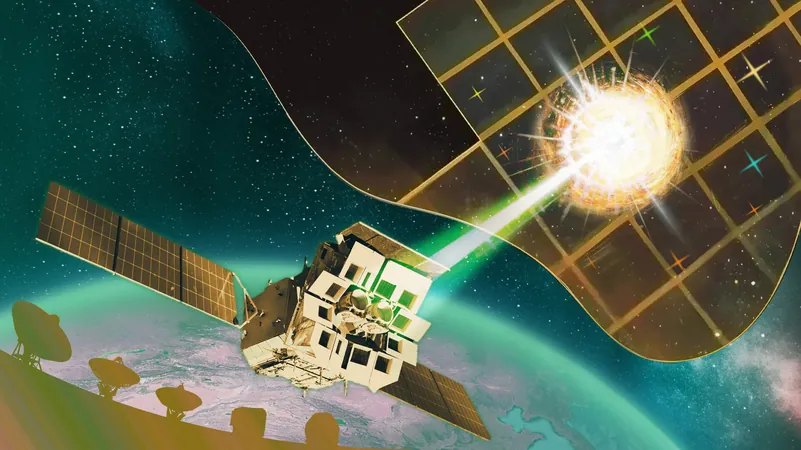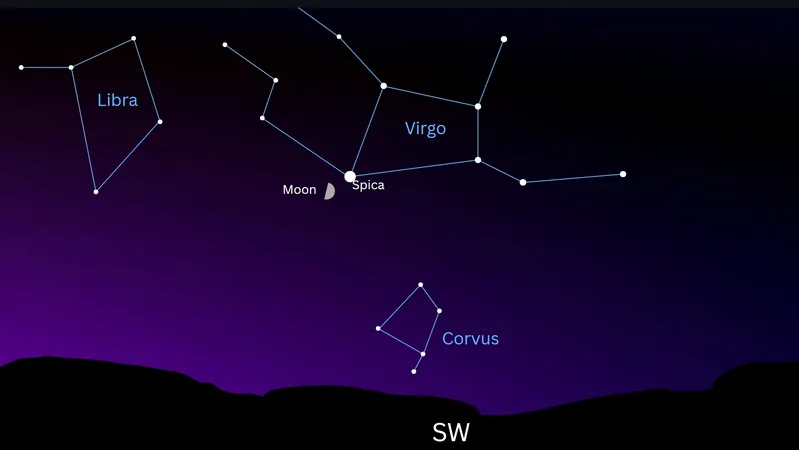
Einstein Probe Unveils Mysterious Cosmic Explosion That Could Redefine Our Understanding of the Universe!
2025-01-23
Author: Jia
A Groundbreaking Discovery
In a groundbreaking discovery, the Einstein Probe, a cutting-edge space observatory launched on January 9, 2024, has remarkably detected a puzzling blast of cosmic X-rays that could revolutionize the way we understand gamma-ray bursts (GRBs). Just under three months after its launch, this spacecraft is already opening up new perspectives on astronomical phenomena from the distant Universe.
On March 15, 2024, the Wide-field X-ray Telescope (WXT) aboard the Einstein Probe captured an unprecedented burst of low-energy X-rays, colloquially known as 'soft' X-rays. This particular event, designated EP240315a, not only lasted for an astonishing 17 minutes but also exhibited fluctuations in brightness, marking it as a rare fast X-ray transient (FXRT). Yuan Liu, a leading astronomer at the National Astronomical Observatories of China, who played a key role in designing the onboard software, expressed his excitement: “Witnessing the algorithm work seamlessly for this event was truly rewarding.”
A Cosmic Journey from 12.5 Billion Light-Years Away!
Approximately one hour after the initial X-ray detection, telescopes in South Africa, part of the Asteroid Terrestrial-Impact Last Alert System (ATLAS), observed visible light emanating from the same location. Follow-up studies using the Gemini-North telescope in Hawaii and the Very Large Telescope in Chile confirmed that this extraordinary burst originated from a staggering 12.5 billion light-years away, dating back to when the Universe was just 10 percent of its current age. This makes EP240315a the oldest detection of soft X-rays from such an explosion—a historic milestone for astronomers.
Xuefeng Wu, a researcher at the Purple Mountain Observatory, noted the significant implications of this finding: “The detection of EP240315a highlights Einstein Probe’s outstanding capability for uncovering transients from the early Universe, enhancing our collaborative international observations.”
The Collaboration That Led to New Discoveries
The timely detection of EP240315a enabled collaboration with international experts like Roberto Ricci from the University of Rome Tor Vergata, who began monitoring the burst at radio wavelengths. Their observations indicated that the energy output corresponded with those typical of gamma-ray bursts, which are immensely powerful cosmic phenomena often resulting from massive star explosions. Notably, EP240315a was connected with GRB 240315C, which had been captured by NASA's Swift Observatory.
Roberto Ricci remarked, “These findings imply that a considerable fraction of FXRTs may be linked with GRBs, emphasizing the precision with which Einstein Probe can identify these ancient explosions amid the cosmos.”
A Cosmic Enigma: X-Rays Before Gamma Rays?
In a puzzling twist, the X-rays from EP240315a were observed over six minutes prior to the gamma-rays of GRB 240315C—an anomaly that could force scientists to reassess existing models of gamma-ray bursts, as Hui Sun from the Einstein Probe Science Center highlighted. “Such a lengthy delay has never been documented,” he said, suggesting that our understanding of GRBs may be more complex than previously thought.
Not only does this challenge our knowledge of these explosive astronomical events, but it also underscores the exceptional capabilities of the Einstein Probe. The mission is poised to further unveil the mysteries of the early Universe, promising more exciting discoveries in the near future.
The Future of Cosmic Exploration with Einstein Probe
As scientists eagerly dissect the observational data, they are optimistic about the capabilities of the Einstein Probe to identify even more cosmic phenomena. Weimin Yuan, the Principal Investigator for the mission, emphasized the immense potential ahead: “This is merely the beginning; we've demonstrated that Einstein Probe can detect cosmic explosions from eras long ago.”
With its two sophisticated instruments—the Wide-field X-ray Telescope and the Follow-up X-ray Telescope—Einstein Probe is set to continue exploring the cosmos, revealing layers of the Universe that have remained shrouded in mystery for far too long.
As Erik Kuulkers, ESA Einstein Probe Project Scientist, aptly put it, “The moment we opened the eyes of the Einstein Probe to the sky, it began uncovering fascinating new phenomena. There's no doubt that countless more discoveries await.”
Conclusion
Stay tuned for the latest revelations that will change our understanding of the Universe!



 Brasil (PT)
Brasil (PT)
 Canada (EN)
Canada (EN)
 Chile (ES)
Chile (ES)
 Česko (CS)
Česko (CS)
 대한민국 (KO)
대한민국 (KO)
 España (ES)
España (ES)
 France (FR)
France (FR)
 Hong Kong (EN)
Hong Kong (EN)
 Italia (IT)
Italia (IT)
 日本 (JA)
日本 (JA)
 Magyarország (HU)
Magyarország (HU)
 Norge (NO)
Norge (NO)
 Polska (PL)
Polska (PL)
 Schweiz (DE)
Schweiz (DE)
 Singapore (EN)
Singapore (EN)
 Sverige (SV)
Sverige (SV)
 Suomi (FI)
Suomi (FI)
 Türkiye (TR)
Türkiye (TR)
 الإمارات العربية المتحدة (AR)
الإمارات العربية المتحدة (AR)